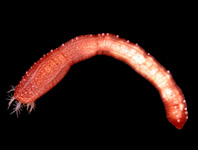Abstract
A new apodid sea cucumber, Chiridota impatiens sp. nov., is described from the intertidal zone of Okinawa, Japan, and C. rigida Semper, 1867 is also described from the intertidal zone of Wakayama, as new to Japan. C. impatiens sp. nov. is approximately 60–70 mm, with 12 tentacles and 4–7 pairs of digits per tentacle, red or reddish brown in living specimens. The tentacles contain curved rod ossicles, with spinous processes and many branches in C. rigida, however, in C. impatiens sp. nov., the curved rod ossicles are crescent-shaped, sometimes distally, with spinous processes and rarely a few branches on the circumference. In both species, the body wall contains flattened rod ossicles, mostly present along the longitudinal muscle and mesentery, curved rod ossicles primarily in the body wall, and wheel ossicles only in the wheel-papillae. In C. rigida, the contents of the wheel-papillae form a hemispherical sack-shaped structures, in which the teeth-side of the wheel ossicles mostly faces towards the outside of the body. In C. impatiens sp. nov., the contents of the wheel-papillae form a cord-shaped structure (present in both preserved and living specimens), in which the teeth-side of the wheel ossicles faces various directions, and that can be induced to break through the skin of the papillae if stimulated in living specimens.
References
Altschul, S.F., Gish, W., Miller, W., Myers, E.W. & Lipman, D.J. (1990) Basic local alignment search tool. Journal of Molecular Biology, 215, 403–410.
https://doi.org/10.1016/S0022-2836(05)80360-2Altschul, S.F., Madden, T.L., Schäffer, A.A., Zhang, J., Zhang, Z., Miller, W. & Lipman, D.J. (1997) Gapped BLAST and PSI-BLAST: a new generation of protein database search programs. Nucleic Acids Research, 25, 3389–3402.
https://doi.org/10.1093/nar/25.17.3389Arndt, A., Marquez, C., Lambert, P. & Smith, M.J. (1996) Molecular phylogeny of eastern Pacific sea cucumbers (Echinodermata: Holothuroidea) based on mitochondrial DNA sequence. Molecular Phylogenetics and Evolution, 6, 425–437.
https://doi.org/10.1006/mpev.1996.0091Brandt, J.F. (1835) Prodromus descriptionis animalium ab H. Mertensio observatorum. Fascic. I. Polypos, Acalephas Discophoras et Siphonophoras, nec non Echinodermata continens. Recueil des Actes de la Séance Publique de l'Académie Impériale des Sciences de St. Pétersbourg, 1834, 201–275.
Chao, S. (1998) Shallow-water sea cucumbers of Taiwan. National Museum of Natural Science of Taiwan, Taizhong, 170 pp. [in Chinese]
Clark, H.L. (1907) The apodous holothurians. Smithsonian Contributions to Knowledge, 35, 1–231.
Deichmann, E. (1930) The holothurians of the western part of the Atlantic Ocean. Bulletin of the Museum of Comparative Zoölogy at Harvard College, LXXI, 43–226.
Edwards, C.L. (1907) The Holothurians of the north Pacific coast of north America collected by the ALBATROSS in 1903. Proceedings U. S. National Museum, XXXIII, 49–68.
https://doi.org/10.5479/si.00963801.33-1558.49Eschscholtz, F. (1829) CHRIDOTA DISCOLOR. In: Eschscholtz, F. (Ed.), Zoologischer Atlas; enthaltend Abbildungen und Beschreibungen neuer Thierarten, wëhrend des Flottcapitains von Kotzebue zweiter Reise um die Welt, auf der Russisch-Kaiserlishen Kriegsschlupp Predpriaetië in den Jahren 1823–1826. Zweites Heft. Reimer, Berlin, pp. 12–13.
Fabricius, O. (1780) HOLOTHURIA LAEVIS. In: Fabricius, O. (Ed.), Fauna Groenlandica; systematice sistens animalia Groenlandicae occidatalis hactenus indagata, quod nomen specificium. Vol. XVI. Hafniae et Lipsiae, Copenhagen, pp. 353–354.
Fisher, W.K. (1907) The holothurians of the Hawaiians Islands. Proceedings U. S. National Museum, XXXII, 637–744.
https://doi.org/10.5479/si.00963801.32-1555.637Folmer, O., Black, M., Hoeh, W., Lutz, R. & Vrijenhoek, R. (1994) DNA primers for amplification of mitochondrial cytochrome oxidase subunit I from diverse metazoan invertebrates. Molecular Marine Biology and Biotechnology, 3, 294–299.
Heding, S.G. (1928) Synaptidae. Papers from Dr. Th. Mortensen's Pacific Expedition 1914–1916. No. 66. Videnskabelige Meddeleser fra Dansk naturhistorisk Forening i København, 85, 105–323.
Imaoka, T. (1995) Holothuroidea. In: Nishimura, S. (Ed.), Guide to Seashore Animals of Japan with Color Pictures and Keys. Vol. II. Hoikusha, Osaka, pp. 553–572. [in Japanese]
Kubota, T. & Inada, K. (2003) Ejection of the wart content including wheel-shaped ossicles from the body wall of the apodid sea cucumber Polycheira fusca (rufescens) induced by mechanical stimulation. Reports of the Faculty of Science Kagoshima University, 36, 103–107.
Liao, Y. & Clark, A.M. (1995) The Echinoderms of Southern China. Science Press, Beijing, 555 pp.
Massin, C. (1996) Results of the Rumphius Biohistorical Expedition to Ambon (1990). Part. 4. The Holothurioidea (Echinodermata) collected at Ambon during the Rumphius Biohistorical Expedition. Zoologische Verhandelingen Leiden, 307, 3–53.
Miller, A.K., Kerr, A.M., Paulay, G., Reich, M., Wilson, N.G., Carvajal, J.I. & Rouse, G.W. (2017) Molecular Phylogeny of Extant Holothuroidea (Echinodermata), Molecular Phylogenetics and Evolution, 111, 110–131.
https://doi.org/10.1016/j.ympev.2017.02.014Ohshima, H. (1914) The Synaptidae of Japan. Annotationes Zoologicae Japonenses, 8, 467–482.
O'Loughlin, P.M. & VandenSpiegel, D. (2012) Sea cucumbers collected by the Kermadec Biodiscovery Expedition 2011 (Echinodermata: Holothuroidea: Apodida and Dendroshirotida). Zootaxa, 3515, 60–66.
Östergren, H. (1898) Das System der Synaptiden. Öfversigt af Kongliga Vetenskaps-Akademiens Förhandlingar, 55, 111–120.
Östergren, H. (1907) Zur Phylogenie und Systematik der Seewalzen. In: Tullberg, T. (Ed.), Särtryck ur Zoologiska Studier Tillägnade. Almquist et Wiksell, Uppsala, pp. 191–215.
Paulay, G. & Hansson, H. (2013) Chiridota Eschscholtz, 1829. Accessed through: World Register of Marine Species. Available from: http://www.marinespecies.org/aphia.php?p=taxdetails&id=123438 (accessed 14 June 2016)
Perrier, M.R. (1904) Sur une nouvelle espèce de Chiridota. Bulletin du Muséum National d'histoir naturelle, 10, 370–372.
Quoy, J.R.C. & Gaimard, J.P. (1833) Voyage de découvertes de l' ASTROLABE. Zoologie, Zoophyte. J. Tastu, Paris, 390 pp.
Selenka, E. (1867) Beiträge zur Anatomie und Systematik der Holothurien. Zeitschrift für Wissenschaftliche Zoologie, 17, 291–374.
Semper, C. (1867–1868) Holothurien. Reisen im Archipel der Philippinen, Teil 2, Wissenschaftliche Resultate. C. W. Kreidel, Wiesbaden, 288 pp.
Verrill, A.E. (1882) Notice of the remarkable marine fauna occupying the outer banks off the southern coast of New England, N° 4. American Journal of Science, 3, 216–225.
https://doi.org/10.2475/ajs.s3-23.135.216Won, J.H. & Rho, B.J. (1998) Two new species and four new records of Holothuroidea from Korea. Korean Journal of Biological Sciences, 2, 9–20.
https://doi.org/10.1080/12265071.1998.9647385Yamana, Y., Hirai, A. & Hirashima, K. (2015) A new species of Thyone (Echinodermata: Holothuroidea: Dendrochirotida: Phyllophoridae) from Wakayama, Japan. Species Diversity, 20, 141–151.
https://doi.org/10.12782/sd.20.2.141

